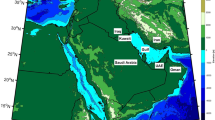Abstract
This paper proposes a simple class of threshold autoregressive model for purpose of forecasting daily maximum ozone concentrations in Southern California. Linear time series model has been widely considered in environmental modeling. However, this class of models fails to capture the nonlinearity in ozone process and the complexity of meteorological interactions with ozone. In this article, we used the threshold autoregressive models with two classes of regimes; periodic and meteorological regimes. Days in week were used for the periodic regimes and the regression tree method was used to define the regimes as a function of meteorological variables. As the reference model we used the autoregressive model with lagged ozone and various lagged meteorological variables as the covariates. The proposed models were applied to a 3-year dataset of daily maximum ozone concentrations obtained from five monitoring stations in San Bernardino County, CA and their forecast performances were evaluated using an independent year-long dataset from the same stations. The results showed that the threshold models well capture the nonlinearity in ozone process and remove the nonstationarity in model residuals. The threshold models outperformed the non-threshold autoregressive models in day-ahead forecasts. The tree-based model showed slightly better performance than the periodic threshold model.






Similar content being viewed by others
References
Akaike H (1974) A new look at statistical model identification. IEEE Trans Automat Contr AC-19:716–723
Bauer G, Deistler M, Scherrer W (2001) Time series models for short term forecasting of ozone in the eastern part of Austria. Environmetrics 12:117–130
Bloomfield P, Royle JA, Steinberg LJ, Yang Q (1996) Accounting for meteorological effects in measuring urban ozone levels and trends. Atmos Environ 30(17):3067–3077
Box GEP, Jenkins GM (1976) Time series analysis: forecasting and control, revised edn. Holden Day, San Francisco
Breiman L, Friedman JH, Olshen RA, Stone CJ (1984) Classification and regression trees. Chapman & Hall, London
Burrows WR, Benjamin M, Beauchamp S (1995) CART decision-tree statistical analysis and prediction of summer season maximum surface ozone for the Vancouver, Montreal, and Atlantic Regions of Canada. J Appl Meteorol 34:1848–1862
Chaloulakou A, Assimacopoulos D, Lekkas T (1999) Forecasting daily maximum ozone concentrations in the Athens Basin. Evrion Monit Assess 56:97–112
Davis MD, Deistler M (1998) Modeling ozone in the Chicago urban area. In: Nychka D, Piegorsch W, Cox LH (eds) Case studies in environmental statistics. Lecture notes in statistics. Springer, Berlin
Fasso A, Negri I (2002) Non-linear statistical modeling of high frequency ground ozone data. Environmetrics 13:225–241
Fiester U, Balzer K (1991) Surface ozone and meteorological predictors on a subregional scale. Atmos Environ 25:1781–1790
Hansen BE (1999) Threshold effects in non-dynamic panels: estimation, testing, and inference. J Econom 93:345–368
Huang L-S, Smith R (1999) Meteorologically-dependent trends in urban ozone. Environmetrics 10:103–118
Kim SE, Kumar A (2005) Accounting seasonal nonstationarity in time series models for short-term ozone level forecast. Stoch Env Res Risk A 19:241–248
Kumar A, Bellam N, Sud A (1999) Performance of industrial source complex model in predicting long-term concentrations in an urban area. Environ Prog 18(2):93–100
Ljung GM, Box GEP (1978) On a measure of lack of fit in time series models. Biometrika 65:297–303
Millionis M, Davies TD (1994) Regression and stochastic models for air pollution-I. Review, comments and suggestion. Atmos Environ 28(17):2801–2810
Monti AC (1994) A proposal for residual autocorrelation test in linear models. Biometrika 81:776–780
Potter SM (1995) A nonlinear approach to US GNP. J Appl Econom 10:109–125
Robeson SM, Steyn DG (1990) Evaluation and comparison of statistical forecast models for daily maximum ozone concentrations. Atmos Environ 24B:303–312
Schwarz F (1978) Estimating the dimension of a model. Ann Stat 6:461–464
Thomson ML, Reynolds J, Lawrence HC, Guttorp P, Sampson PD (2001) A review of statistical methods for the meteorological adjustment of tropospheric ozone. Atmos Environ 35:617–630
Tiao GC, Tsay RS (1994) Some advances in non-linear and adaptive modelling in time series. J Forecast 13:109–131
Tong H (1983) Threshold models in non-linear time series analysis. In: Brillinger D, Fienberg J, Gani J, Hartigan J, Krickberg K (eds) Lecture notes in statistics. Springer, Heidelberg
Tong H (1990) Nonlinear time series: a dynamic system approach. Oxford University Press, Oxford
Venables WN, Ripley BD (2002) Modern applied statistics with S. Fourth Ed. Springer, Heidelberg
Acknowledgment
This work was supported in part by a grant from California State University, Long Beach, SCAC program.
Author information
Authors and Affiliations
Corresponding author
Rights and permissions
About this article
Cite this article
Kim, S.E. Tree-based threshold modeling for short-term forecast of daily maximum ozone level. Stoch Environ Res Risk Assess 24, 19–28 (2010). https://doi.org/10.1007/s00477-008-0295-6
Published:
Issue Date:
DOI: https://doi.org/10.1007/s00477-008-0295-6




